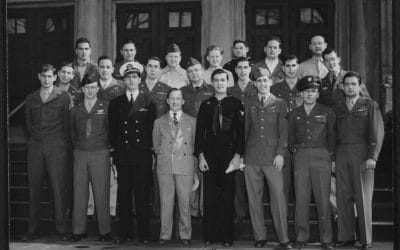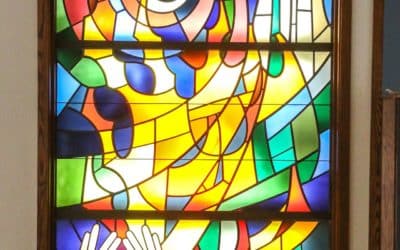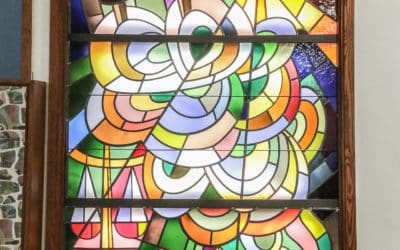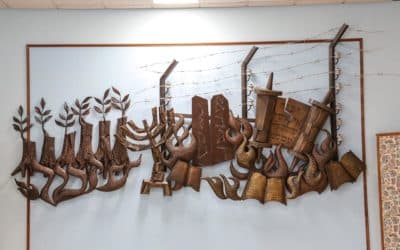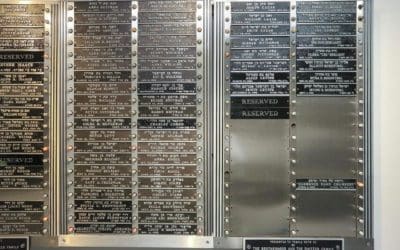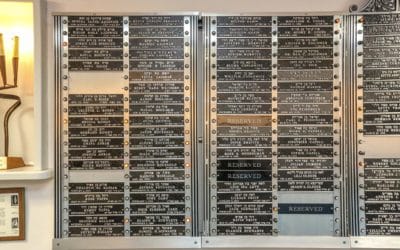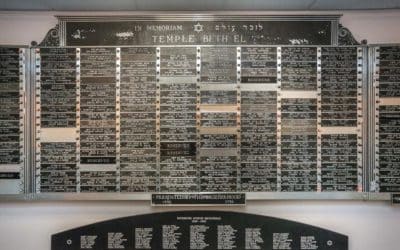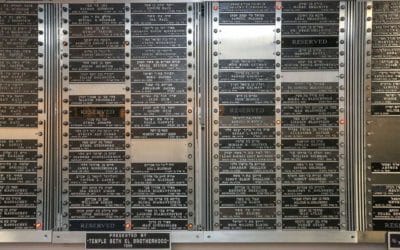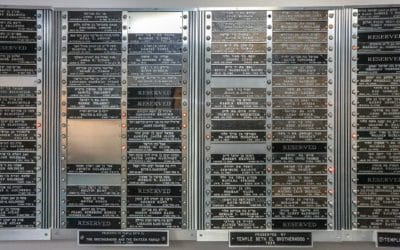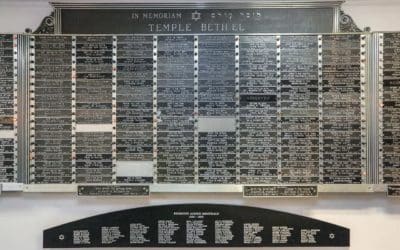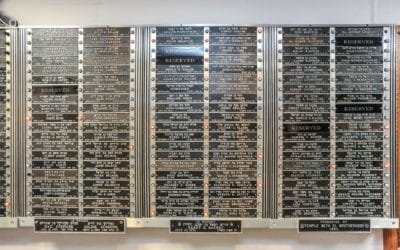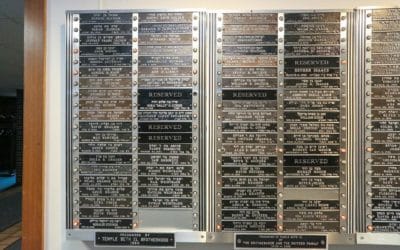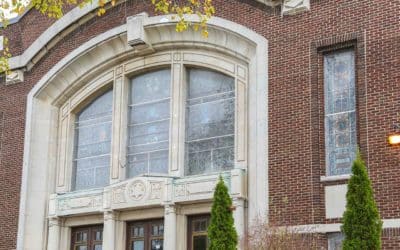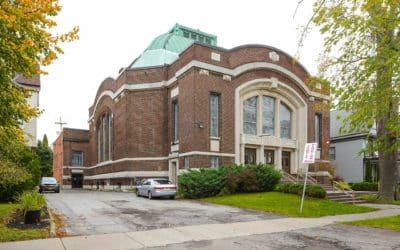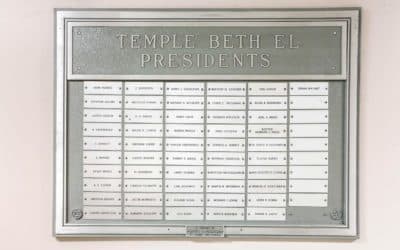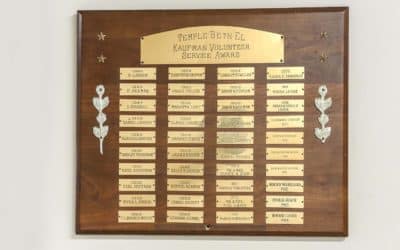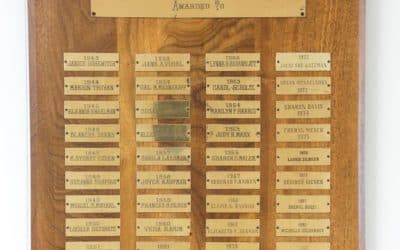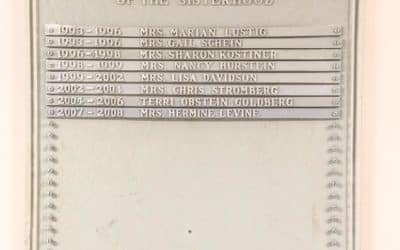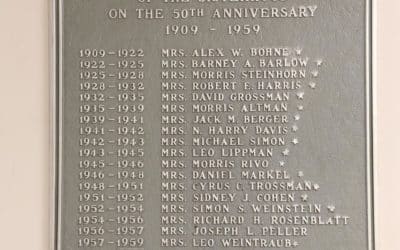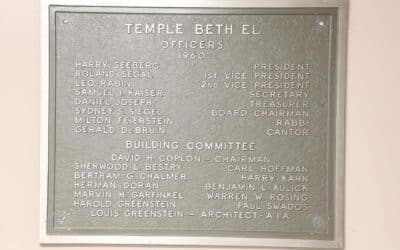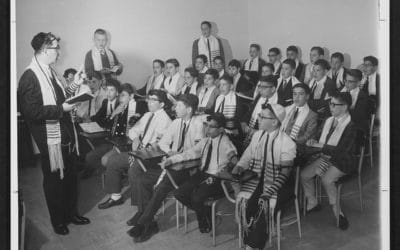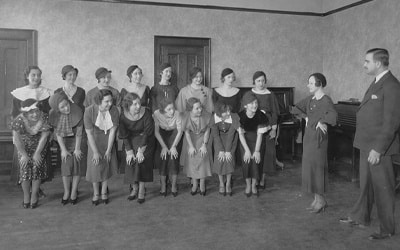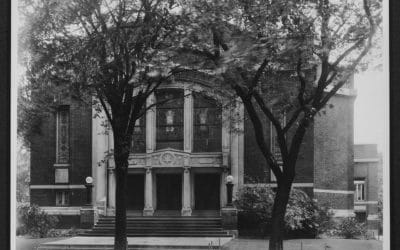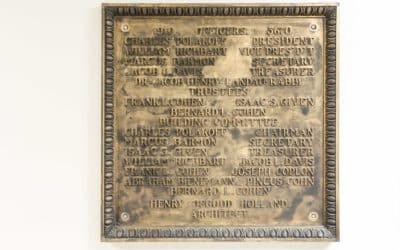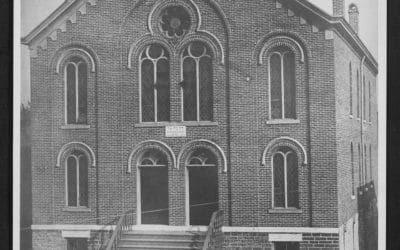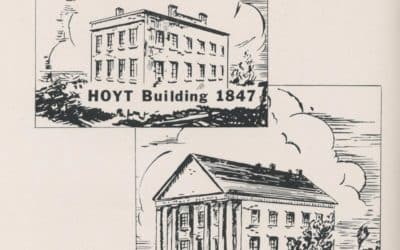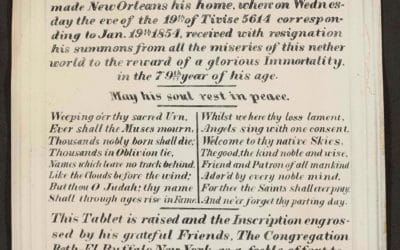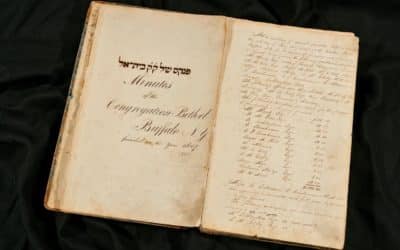Synagogues / Temple Beth El
Temple Beth El, founded as Congregation Bethel was the first synagogue to be established in Buffalo in 1847. Soon after its formation it changed its name to Temple Beth El. The congregation moved several times within the city, eventually settling on Richmond Avenue for many decades. In the 1960s it moved to a suburban site in the Town of Tonawanda. In 2008, it merged with Temple Shaarey Zedek to form Temple Beth Tzedek.
Overview
Beginnings
Until the late 1840s, Buffalo’s Jewish population was transitory and too small to support a congregation. In 1847, however, an affiliated community coalesced as the first Jewish congregation established as “Congregation Beth-el.” At a meeting on May 9, 1847 held at the Buffalo Western Hotel, a small group of Polish Jewish immigrants and German Jewish immigrants established a congregation of “moderate” orthodox ritual. In the early days, members met in local homes and then began to rent premises, first at Concert Hall on the southwest corner of Main and Swan Street for services. By April 1848, Temple Beth El, as it was now known, adopted a formal constitution and by-laws, and two years later the congregation was large enough to purchase an old schoolhouse on the block around Main, Pearl, Eagle and Court streets, holding their first service on July 22, 1850.
Financial stability was provided through a bequest from Judah Touro, a philanthropist from the small Jewish community of Rhode Island who died childless and left bequests for a number of Jewish congregations throughout the United States. Outgrowing the Pearl Street location, the congregation established a new synagogue home on Elm Street in 1873 where they remained for the next thirty years. In 1909, a desire for a location further uptown led to the selection of a site on Richmond Avenue. The synagogue complex was designed by local architect Henry Osgood Holland, and the new building was dedicated in 1911. The drive for the new site and was led by Charles Polakoff, a real estate and insurance agent, who as President, led the congregation almost continually for the next three decades, from 1909 into the 1930s.
At the Richmond Avenue site, Temple Beth El entered a golden age. Expansion continued in the years after WWI as the synagogue became a “synagogue-center,” offering a wide range of clubs and activities. A popular basketball club and a bar mitzvah Brotherhood encouraged social and religious ties. The Annual Ball, regular dances, and several choirs, one of which was led by Samuel Luskin and the Women’s and Men’s Temple Societies, supported a significant social entertainment calendar. The Temple produced plays and musicals that were performed at local Concert Halls, theatres and the Statler Hotel drawing audiences from beyond the temple community. Although the synagogue struggled in the 1930s as did most organizations in the aftermath of the Great Depression, in the 1940s, greater stability returned. Its members were active in war bonds drives and Rabbi Elihu Rickel served as a military chaplain. Temple Beth El listed over 100 members who served during WWII across four military branches. In the post war era, Temple Beth El celebrated its centennial in the spring of 1947 with a banquet and play, “Through the Years”.
Despite the surer footing, and an expanded religious school for bar and bat mitzvah students from the 1940s, demographics became a shaping factor during the 1950s and the search for a location in the suburbs became a growing demand.
Suburbia, the Town of Tonawanda and Eggert Road
The attraction of the suburbs increased as many members relocated from the West Side of Buffalo, North Buffalo and Kenmore to Tonawanda, Amherst and Getzville. Like congregations in other streams of Judaism and Conservative congregations around the country, the push for the suburbs came from the membership, not the leadership. By the late 1950s Benjamin L. Kulick led a building fund campaign to raise funds for a religious school plan, with Louis Greenstein as architect. The Building Construction Committee was led by David Coplon, whose family had played a significant role in the creation of the Rosa Coplon Old People‘s Home. The construction of a one-story school on Eggert Road in the Town of Tonawanda began in 1960. With an eye on the future, the building had the capacity to add a second level as well as an all-purpose meeting place. By the time the congregation celebrated the school’s dedication ceremonies in April 1961, with an illustrated souvenir booklet incorporating images by member-photographer, Frederic Marschall, plans were already advanced to increase the school’s footprint. With plans for a sanctuary beyond a meeting room, in 1966, on October 9, the final service at the Richmond Avenue building brought a torah procession from the city to the suburbs. Calamity struck in 1978 when part of the new building was destroyed by fire. Rebuilding and expansion plans accelerated in earnest with the building of a new sanctuary and the addition of the Rabbi Samuel I. Porrath foyer in recognition of his fiftieth year in the rabbinate. Plans for new classrooms, a bridal room, a large library, museum and basement archives were developed over the next few years and Temple Beth El became convening place for the community, as local Jewish organizations for rented meeting space. Beth El provided a home for the Kadimah School of Buffalo, and the United Jewish High School of Jewish Studies, as well as Tikvah, the combined congregational religious school.
Commemoration and Merger
In 1997, a major celebration of the 150th anniversary of Temple Beth El saw members “return” to Richmond Avenue, now the home of Temple Emanuel Church. Although this was a congregational highpoint, the late 1990s and early 2000s saw a significant decline in members as the population aged, and the number of families with children affiliating dropped. In 2000, Cantor Gerald DeBruin was honored for serving as the congregation’s hazzan for fifty years. Five years later, the economics of citywide decline convinced Temple Beth El members to consider selling their property and moving to a smaller location nearer to Williamsville. In 2008 Temple Beth El voted to sell Eggert Road and merge with Temple Shaarey Zedek to form Temple Beth Tzedek.
Locations
Documents
Rabbi Samuel Porrath, Golden Jubilee Banquet
The Rajah, Program Booklet, Young Women’s Club of Temple Beth El, 1924, courtesy of Carol Schmeidler.
The Rajah, Program Booklet
The Rajah, Program Booklet, Young Women’s Club of Temple Beth El, 1924, courtesy of Carol Schmeidler.
Temple Beth-El School Dedication, 1961
Temple Beth-El School Dedication, 1961, Temple Beth El Collection, Courtesy of TBZ Cofeld Judaic Museum.
Articles
An emotional shalom as synagogue ends—and begins Temple Beth El holds final service as historic congregation merges
An emotional shalom as synagogue ends—and begins Temple Beth El holds final service as historic congregation merges, Buffalo News, June 10, 2008
Synagogues ready vote for May 14 on merging Shaarey Zedek, Beth El affected
Synagogues ready vote for May 14 on merging Shaarey Zedek, Beth El affected, Buffalo News, Apr 10, 2008
Members vote to merge two temples
Members vote to merge two temples, Buffalo News, May 16, 2008
Gallery
Men in military uniforms on the steps of Temple Beth El, image created by Frederic Marschall, Temple Beth El collection, ms222, University Archives, University at Buffalo. Used with Permission.
Men in military uniforms on the steps of Temple Beth El
Stained Glass from Temple Beth El, Eggert Road photographed at Temple Beth Tzedek, Getzville, photograph created by Izon Productions-Don Dannecker, 2017. Courtesy of the Foundation for Jewish Philanthropies.
Stained Glass from Temple Beth El 2
Stained Glass from Temple Beth El, Eggert Road photographed at Temple Beth Tzedek, Getzville, photograph created by Izon Productions-Don Dannecker, 2017. Courtesy of the Foundation for Jewish Philanthropies.
Stained Glass from Temple Beth El
Recalling the Holocaust, commissioned for Temple Beth El at Eggert Road, and photographed at Temple Beth Tzedek, Getzville Road, photograph created by Izon Productions-Don Dannecker, 2017. Courtesy of the Foundation for Jewish Philanthropies.
Recalling the Holocaust
Temple Beth El, Memorial Plaques, photograph created by Izon Productions-Don Dannecker, 2017. Courtesy of the Foundation for Jewish Philanthropies.
Temple Beth El, Memorial Plaques 9
Temple Beth El, Memorial Plaques, photograph created by Izon Productions-Don Dannecker, 2017. Courtesy of the Foundation for Jewish Philanthropies.
Temple Beth El, Memorial Plaques 8
Temple Beth El, Memorial Plaques, photograph created by Izon Productions-Don Dannecker, 2017. Courtesy of the Foundation for Jewish Philanthropies.
Temple Beth El, Memorial Plaques 7
Temple Beth El, Memorial Plaques, photograph created by Izon Productions-Don Dannecker, 2017. Courtesy of the Foundation for Jewish Philanthropies.
Temple Beth El, Memorial Plaques 6
Temple Beth El, Memorial Plaques, photograph created by Izon Productions-Don Dannecker, 2017. Courtesy of the Foundation for Jewish Philanthropies.
Temple Beth El, Memorial Plaques 5
Temple Beth El, Memorial Plaques, photograph created by Izon Productions-Don Dannecker, 2017. Courtesy of the Foundation for Jewish Philanthropies.
Temple Beth El, Memorial Plaques 4
Temple Beth El, Memorial Plaques, photograph created by Izon Productions-Don Dannecker, 2017. Courtesy of the Foundation for Jewish Philanthropies.
Temple Beth El, Memorial Plaques 3
Temple Beth El, Memorial Plaques, photograph created by Izon Productions-Don Dannecker, 2017. Courtesy of the Foundation for Jewish Philanthropies.
Temple Beth El, Memorial Plaques 2
Temple Beth El, Memorial Plaques, photograph created by Izon Productions-Don Dannecker, 2017. Courtesy of the Foundation for Jewish Philanthropies.
Temple Beth El, Memorial Plaques
Former Temple Beth El, designed by Henry Osgood Holland, close up of the front of the building to show Star of David embellishments, photograph created by Izon Productions-Don Dannecker, 2017. Courtesy of the Foundation for Jewish Philanthropies.
Former Temple Beth El Close Up
Former Temple Beth El, designed by Henry Osgood Holland, close up of the front of the building to show stained glass, photograph created by Izon Productions-Don Dannecker, 2013. Courtesy of the Foundation for Jewish Philanthropies.
Former Temple Beth El Window
Former Temple Beth El building, designed by Henry Osgood Holland, side view, Richmond Avenue, photograph created by Izon Productions-Don Dannecker, 2017. Courtesy of the Foundation for Jewish Philanthropies.
Former Temple Beth El Building
Temple Beth El, Sanctuary Building Committees at Eggert Road location, Town of Tonawanda, 1982, photograph created by Izon Productions-Don Dannecker, 2017. Courtesy of the Foundation for Jewish Philanthropies.
Temple Beth El, Sanctuary Building Committees at Eggert Road
Temple Beth El Presidents, photograph created by Izon Productions-Don Dannecker, 2017. Courtesy of the Foundation for Jewish Philanthropies.
Temple Beth El Presidents
Temple Beth El Kaufman Service Award, 1945-1984, photograph created by Izon Productions-Don Dannecker, 2017. Courtesy of the Foundation for Jewish Philanthropies.
Temple Beth El Kaufman Service Award, 1945-1984
Temple Beth El Religious School, Marlene J. Simms Memorial Award, 1943-1993, photograph created by Izon Productions-Don Dannecker, 2017. Courtesy of the Foundation for Jewish Philanthropies.
Temple Beth El Religious School, Marlene J. Simms Memorial Award, 1943-1993
Temple Beth El, Presidents of the Sisterhood, 1993-2008, photograph created by Izon Productions-Don Dannecker, 2017. Courtesy of the Foundation for Jewish Philanthropies.
Temple Beth El, Presidents of the Sisterhood, 1993-2008
Temple Beth El, Presidents of the Sisterhood, 1962-1993, photograph created by Izon Productions-Don Dannecker, 2017. Courtesy of the Foundation for Jewish Philanthropies.
Temple Beth El, Presidents of the Sisterhood, 1962-1993
Temple Beth El, Presidents of the Sisterhood, 1909-1959, photograph created by Izon Productions-Don Dannecker, 2017. Courtesy of the Foundation for Jewish Philanthropies.
Temple Beth El, Presidents of the Sisterhood, 1909-1959
Beth El Religious School, Building Plaque, Temple Beth El, 1960, photograph created by Izon Productions-Don Dannecker, 2017. Courtesy of the Foundation for Jewish Philanthropies.
Beth El Religious School, Building Plaque, Temple Beth El, 1960
Cantor Gerald DeBruin leading the Bar Mitzvah Brotherhood, Temple Beth El, 1950s, photograph created by Frederic Marschall, Ms222, Temple Beth El Collection, University Archives, University at Buffalo, State University of New York at Buffalo, used with permission.
Cantor Gerald DeBruin leading the Bar Mitzvah Brotherhood
Temple Beth El, Girl Scout Troop, 1950
Temple Beth El, Beth El WWII Servicemen in uniforms on the steps of Temple Beth El, 1943, photograph created by Frederic Marschall, Ms222, Temple Beth El Collection, University Archives, University at Buffalo, State University of New York at Buffalo, used with permission.
Temple Beth El, Beth El WWII Servicemen in uniforms on the steps of Temple Beth El, 1943
Temple Beth El, Young Women in rehearsal, c1920s, photograph created by Hauser Bob and Sons, Ms222, Temple Beth El Collection, University Archives, University at Buffalo, State University of New York at Buffalo, used with permission.
Temple Beth El, Young Women in Rehearsal, c1920s
Temple Beth El, Richmond Avenue, c.1920s photograph created by Hauser Bob and Sons, Ms222, Temple Beth El Collection, University Archives, University at Buffalo, State University of New York at Buffalo, used with permission.
Temple Beth El, Richmond Avenue, c.1920s
Officers Plaque, 1910, Temple Beth El, photograph created by Izon Productions-Don Dannecker, 2013. Courtesy of the Foundation for Jewish Philanthropies.
Officers Plaque, 1910, Temple Beth El
Temple Beth El, Elm Street synagogue, c1909. Photographer unknown, Ms222, Temple Beth El Collection, University Archives, University at Buffalo, State University of New York at Buffalo, used with permission.
Temple Beth El, Elm Street Synagogue, c1909
Temple Beth El congregational locations before 1909, Centenary Anniversary Booklet, Temple Beth El Collection, Courtesy of TBZ Cofeld Judaic Museum.
Temple Beth El Congregational Locations Before 1909
Judah Toura plaque to honor his bequest to Beth El, undated, photograph created by Frederic Marschall, Ms222, Temple Beth El Collection, University Archives, University at Buffalo, State University of New York at Buffalo, used with permission.
Judah Toura plaque to honor his bequest to Beth El
render as Temple Beth El, Minute Book, 1847, Ms222, Temple Beth El Collection, photograph created by Izon Productions-Don Dannecker, 2013. Courtesy of the Foundation for Jewish Philanthropies.
render as Temple Beth El, Minute Book, 1847
Discover More
- A significant archival collection is held at The University Archives, University at Buffalo.
Contribute to this page
We are seeking internal and external photographs, documents, film, mementos and written recollections relating to Temple Beth El for digitization. If you have materials you’d like to make available for this purpose, please contact us.
Thank you
Our thanks to individual donors, the University at Buffalo, the Foundation for Jewish Philanthropies, Temple Beth Tzedek and the Cofeld Judaic Museum for source materials used in the creation of this entry.




